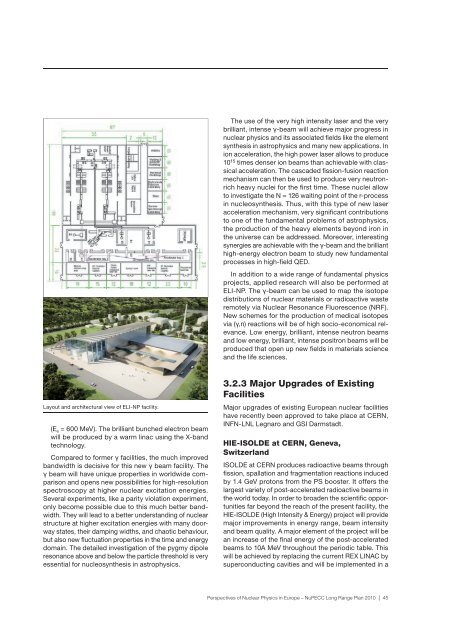Perspectives of Nuclear Physics in Europe - European Science ...
Perspectives of Nuclear Physics in Europe - European Science ...
Perspectives of Nuclear Physics in Europe - European Science ...
Create successful ePaper yourself
Turn your PDF publications into a flip-book with our unique Google optimized e-Paper software.
The use <strong>of</strong> the very high <strong>in</strong>tensity laser and the very<br />
brilliant, <strong>in</strong>tense γ-beam will achieve major progress <strong>in</strong><br />
nuclear physics and its associated fields like the element<br />
synthesis <strong>in</strong> astrophysics and many new applications. In<br />
ion acceleration, the high power laser allows to produce<br />
10 15 times denser ion beams than achievable with classical<br />
acceleration. The cascaded fission-fusion reaction<br />
mechanism can then be used to produce very neutronrich<br />
heavy nuclei for the first time. These nuclei allow<br />
to <strong>in</strong>vestigate the N = 126 wait<strong>in</strong>g po<strong>in</strong>t <strong>of</strong> the r-process<br />
<strong>in</strong> nucleosynthesis. Thus, with this type <strong>of</strong> new laser<br />
acceleration mechanism, very significant contributions<br />
to one <strong>of</strong> the fundamental problems <strong>of</strong> astrophysics,<br />
the production <strong>of</strong> the heavy elements beyond iron <strong>in</strong><br />
the universe can be addressed. Moreover, <strong>in</strong>terest<strong>in</strong>g<br />
synergies are achievable with the γ-beam and the brilliant<br />
high-energy electron beam to study new fundamental<br />
processes <strong>in</strong> high-field QED.<br />
In addition to a wide range <strong>of</strong> fundamental physics<br />
projects, applied research will also be performed at<br />
ELI-NP. The γ-beam can be used to map the isotope<br />
distributions <strong>of</strong> nuclear materials or radioactive waste<br />
remotely via <strong>Nuclear</strong> Resonance Fluorescence (NRF).<br />
New schemes for the production <strong>of</strong> medical isotopes<br />
via (γ,n) reactions will be <strong>of</strong> high socio-economical relevance.<br />
Low energy, brilliant, <strong>in</strong>tense neutron beams<br />
and low energy, brilliant, <strong>in</strong>tense positron beams will be<br />
produced that open up new fields <strong>in</strong> materials science<br />
and the life sciences.<br />
Layout and architectural view <strong>of</strong> ELI-NP facility.<br />
(E e = 600 MeV). The brilliant bunched electron beam<br />
will be produced by a warm l<strong>in</strong>ac us<strong>in</strong>g the X-band<br />
technology.<br />
Compared to former γ facilities, the much improved<br />
bandwidth is decisive for this new γ beam facility. The<br />
γ beam will have unique properties <strong>in</strong> worldwide comparison<br />
and opens new possibilities for high-resolution<br />
spectroscopy at higher nuclear excitation energies.<br />
Several experiments, like a parity violation experiment,<br />
only become possible due to this much better bandwidth.<br />
They will lead to a better understand<strong>in</strong>g <strong>of</strong> nuclear<br />
structure at higher excitation energies with many doorway<br />
states, their damp<strong>in</strong>g widths, and chaotic behaviour,<br />
but also new fluctuation properties <strong>in</strong> the time and energy<br />
doma<strong>in</strong>. The detailed <strong>in</strong>vestigation <strong>of</strong> the pygmy dipole<br />
resonance above and below the particle threshold is very<br />
essential for nucleosynthesis <strong>in</strong> astrophysics.<br />
3.2.3 Major Upgrades <strong>of</strong> Exist<strong>in</strong>g<br />
Facilities<br />
Major upgrades <strong>of</strong> exist<strong>in</strong>g <strong>Europe</strong>an nuclear facilities<br />
have recently been approved to take place at CERN,<br />
INFN-LNL Legnaro and GSI Darmstadt.<br />
HIE-ISOLDE at CERN, Geneva,<br />
Switzerland<br />
ISOLDE at CERN produces radioactive beams through<br />
fission, spallation and fragmentation reactions <strong>in</strong>duced<br />
by 1.4 GeV protons from the PS booster. It <strong>of</strong>fers the<br />
largest variety <strong>of</strong> post-accelerated radioactive beams <strong>in</strong><br />
the world today. In order to broaden the scientific opportunities<br />
far beyond the reach <strong>of</strong> the present facility, the<br />
HIE-ISOLDE (High Intensity & Energy) project will provide<br />
major improvements <strong>in</strong> energy range, beam <strong>in</strong>tensity<br />
and beam quality. A major element <strong>of</strong> the project will be<br />
an <strong>in</strong>crease <strong>of</strong> the f<strong>in</strong>al energy <strong>of</strong> the post-accelerated<br />
beams to 10A MeV throughout the periodic table. This<br />
will be achieved by replac<strong>in</strong>g the current REX LINAC by<br />
superconduct<strong>in</strong>g cavities and will be implemented <strong>in</strong> a<br />
<strong>Perspectives</strong> <strong>of</strong> <strong>Nuclear</strong> <strong>Physics</strong> <strong>in</strong> <strong>Europe</strong> – NuPECC Long Range Plan 2010 | 45
















